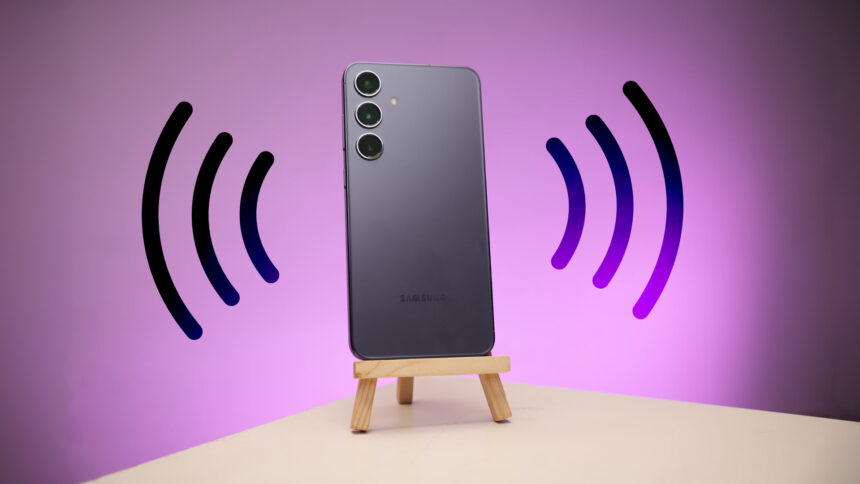The pace of radical innovation for the regular smartphone has definitely been leisurely, as the product itself nears perfection. The upgrades we see today are less groundbreaking and more about refinement, and this will likely be the case for the Samsung Galaxy S25 too.
Amidst this slowdown, brands are integrating the next major advancement, AI, to edit photos or generate text, to make their phones stand out. However, our recent investigation has unearthed evidence that Samsung might be pioneering another front too—roaming and connectivity.
Our findings point to a technology that will possibly debut with the S25, enabling the device to improve how fast and accurately it connects to networks when roaming outside your home country. This tech could dramatically streamline the experience for international travelers using Samsung devices.
Editorial Integrity and Transparency
This article presents information from public sources, derived through in-depth research conducted by TrueTech. We can confirm that no ongoing agreements and/or communications with Samsung have taken place in regards to this matter, ensuring no confidentiality breaches.
Samsung Galaxy S25 May Get New Roaming Technology
While recently navigating the LinkedIn labyrinth to connect with experts at Samsung for interviews, we happened to chance upon subtle but interesting clues that pointed us to this new roaming technology the S25 may sport.
Clue 1: LinkedIn Profile
On the LinkedIn profile (that we also archived) of a former Samsung Intern, Brian (Joon Yong) Hwang, we discovered a prominent mention of the S25 and the following text that shed light on the improved roaming technology:
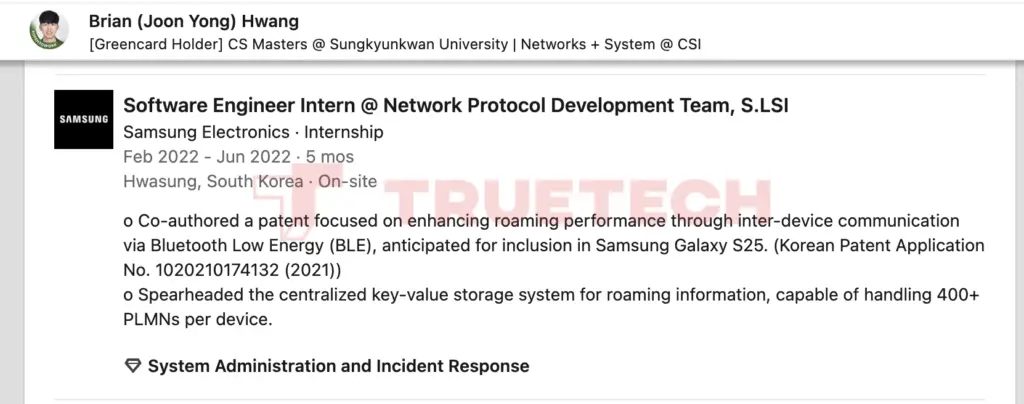
Co-authored a patent focused on enhancing roaming performance through inter-device communication via Bluetooth Low Energy (BLE), anticipated for inclusion in Samsung Galaxy S25. (Korean Patent Application No. 1020210174132 (2021))
Experience listed on Brian (Joon Yong) Hwang’s LinkedIn Profile, first discovered by TrueTech
Hwang’s achievement and co-authorship of the Samsung patent from 2021 hints at Samsung’s endeavour to making roaming connectivity easier and faster, using BLE (Bluetooth Low Energy).
Hwang also mentioned that this new technology is “anticipated” to be included in the upcoming, S25 that might launch early next year. In the same part of his LinkedIn profile, Hwang also took pride in another notable achievement:
“Spearheaded the centralized key-value storage system for roaming information, capable of handling 400+ PLMNs per device”
Experience listed on Brian (Joon Yong) Hwang’s LinkedIn Profile, first discovered by TrueTech
The statement above sheds light on a possible new centralized system that Samsung designed to manage a wide range of public land mobile networks (PLMNs). This also indicates a strong upgrade in how Samsung devices could handle network switches during international travel.
Hwang also had his resume on his profile at the time of writing this report, which further detailed his internship experience while co-authoring this patent:

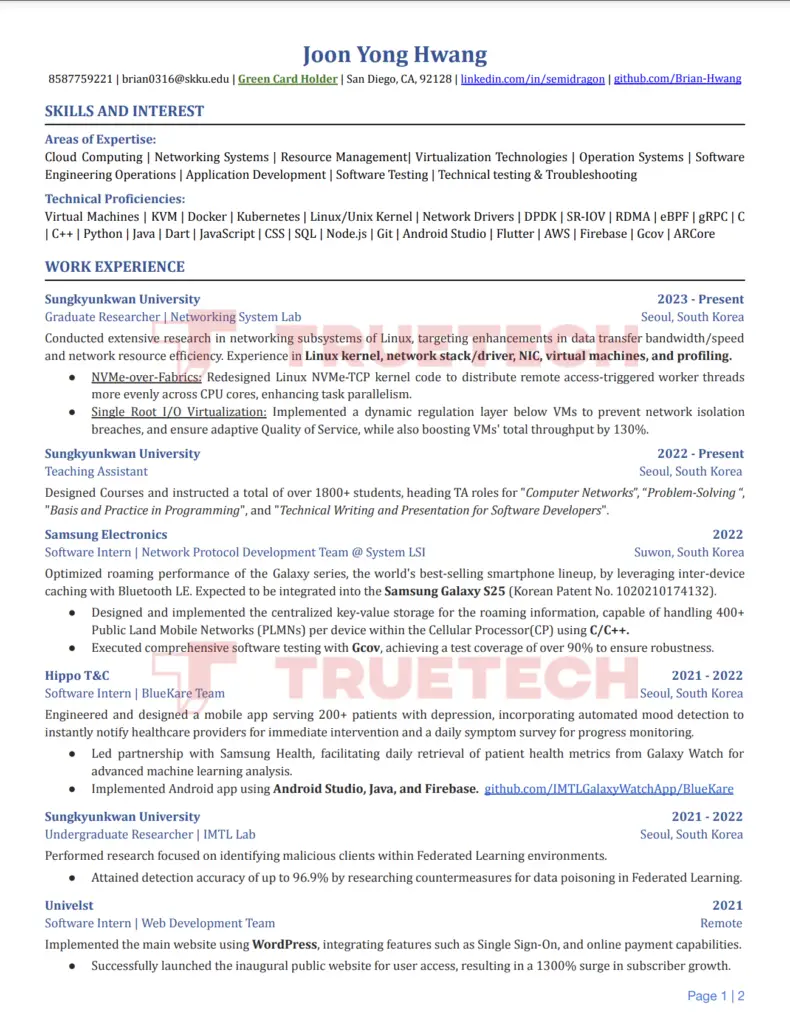
Designed and implemented the centralized key-value storage for the roaming information, capable of handling 400+ Public Land Mobile Networks (PLMNs) per device within the Cellular Processor(CP) using C/C++.
Executed comprehensive software testing with Gov, achieving a test coverage of over 90% to ensure robustness.
Experience as listed on Brian (Joon Yong) Hwang’s Resume found on LinkedIn, first discovered by TrueTech
These insights from Hwang’s resume paint an even clearer picture of the technical groundwork that might be underpinning the patent’s application in real-world devices.
Clue 2: Samsung’s Patent
Being intrigued by those details, we decided to assess the patent through official sources. We turned to Korea Intellectual Property Rights Information Service (KIPRIS) to validate the patent.
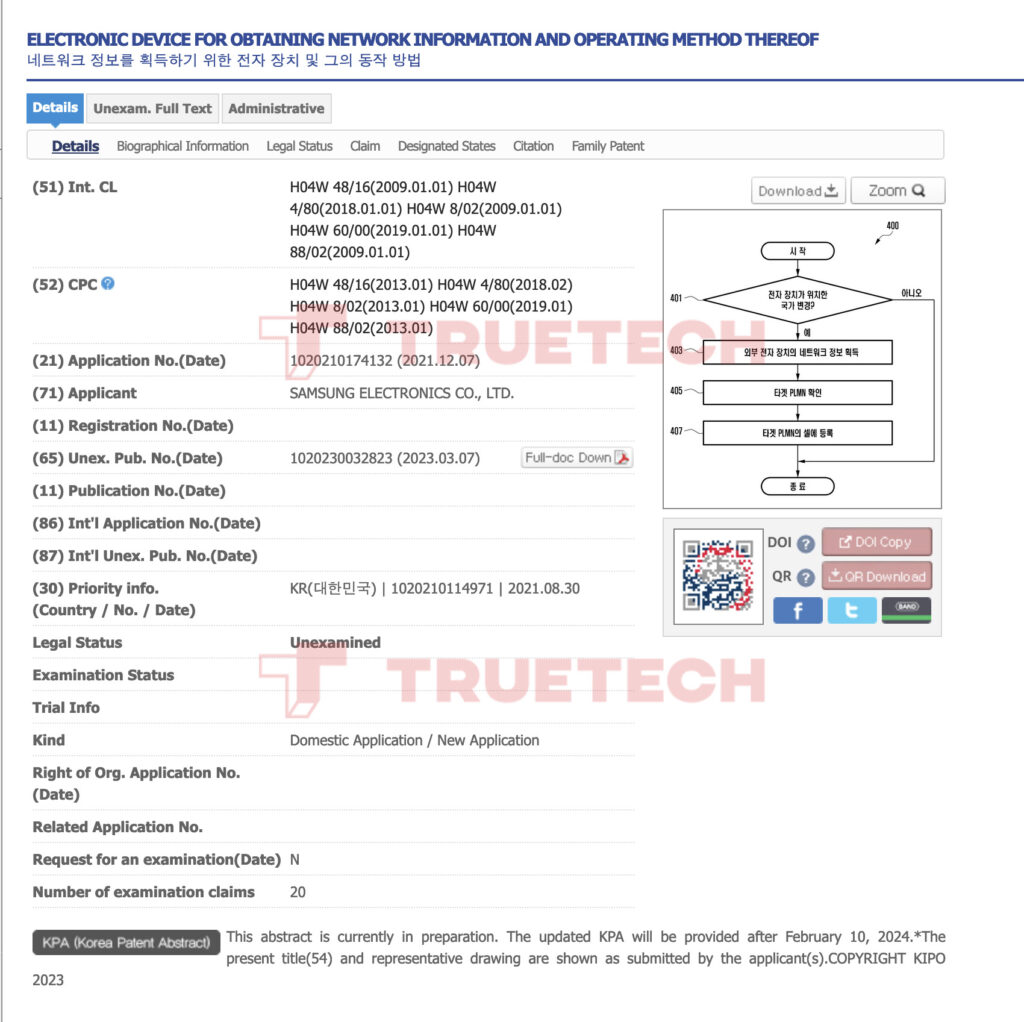
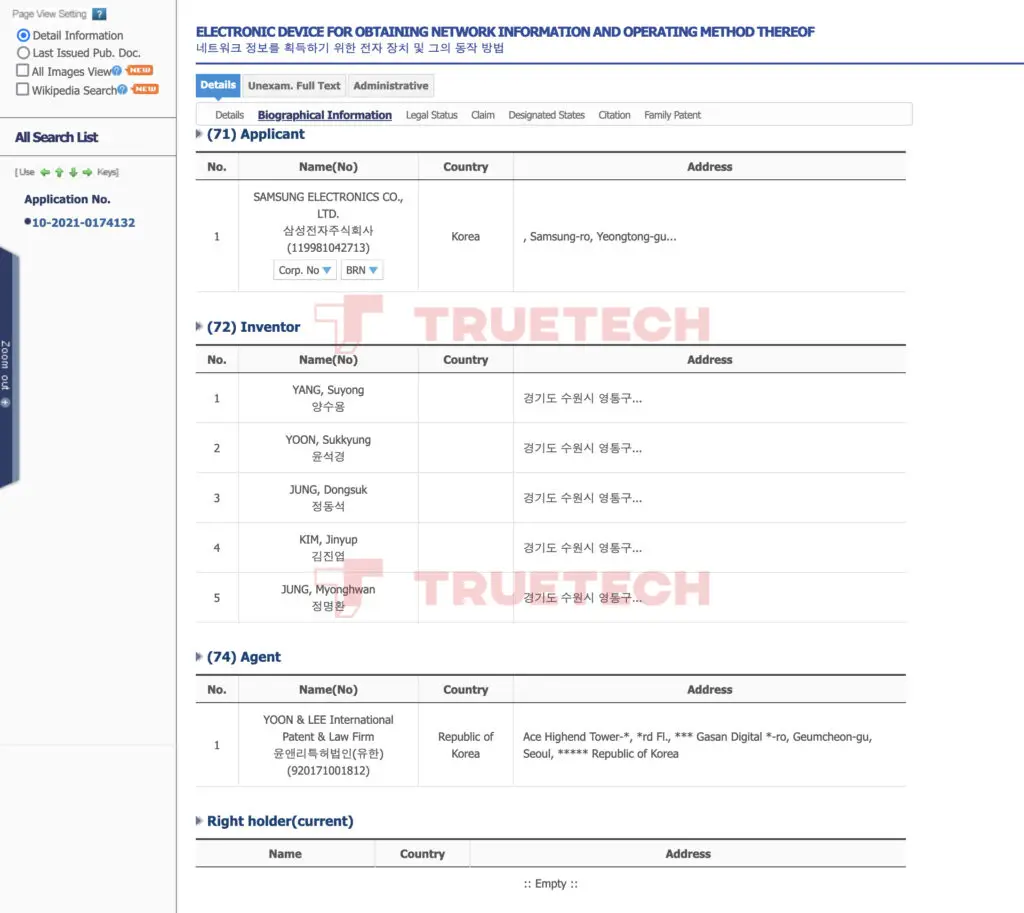
Eventually, we located it and confirmed that it was filed by Samsung on 7th December 2021. This was a rather curious detail given that Hwang’s internship ranged from February 2022 to June 2022.
Nonetheless, as we dove deeper into the patent, we were able to confirm its contents including Samsung’s claims about the tech, and diagrams presented originally in Korean.
Understanding the Patent: From Jargon to Clarity
Given the patent was originally in Korean, we used a combination of AI and Google Translate to translate the patent to English, and hired an engineer to help us decode the patent. Going through this process we realized that the 20 claims listed on the KIPRIS website summarize the entire patent and its technical information well.
The patent describes a new system that Samsung has worked on to improve roaming capabilities of smartphones. The essential claims can be summarized below:
- The technology includes a memory to store information and two circuits for communication: one for cellular communication, and another for Bluetooth Low Energy (BLE) integration. There will be at least one processor that interlinks these components.
- The processor will be responsible to detect when the phone is in a new country (i.e. roaming).
- Upon detecting presence in a foreign land, the phone will use BLE to communicate with devices nearby to decide the best available network to connect to. This process will either be preferred over using cellular networks or used in conjunction with the traditional method.
- The processor also identifies Public Land Mobile Networks (PLMNs) using the information gathered and then manages searches and registrations through the cellular communication circuit.
In Layman’s Terms
What is BLE?
Bluetooth Low Energy (BLE) is a technology designed to transmit data over short distances from one device to another. BLE uses very small amounts of power, affecting your battery almost negligibly. This technology is often used in fitness trackers and smartwatches amongst other devices to communicate tiny amounts of data. Think of it like a lighthouse that emits signals intermittently, guiding nearby ships.
What are PLMNs?
Public Land Mobile Networks (PLMNs) are the official networks that mobile operators provide in a country. It is essentially the network your phone connects to to receive calls, texts or use data.
What does the patent say?
Imagine you are traveling to a different country with your new Samsung Galaxy S25. The moment you land and turn off your Airplane mode, your phone needs to search for the best network to connect to, so that you can continue receiving calls, texts or using your data.
Normally, a phone would use traditional cellular signals to figure out the best network, which not only can be slow, but also costly.
However, the S25 will use BLE to talk to other devices nearby that are already connected to the best network, and use that information to connect your device to the same network as well. Think of it as asking locals for advice instead of trying to follow an internet guide or figuring it out all on your own while traveling. However, at this point, it is unclear if the nearby devices also have to be Samsung devices for this technology to function as suggested.
Technical workflow explained:
Here is the main technical workflow diagram from the patent:
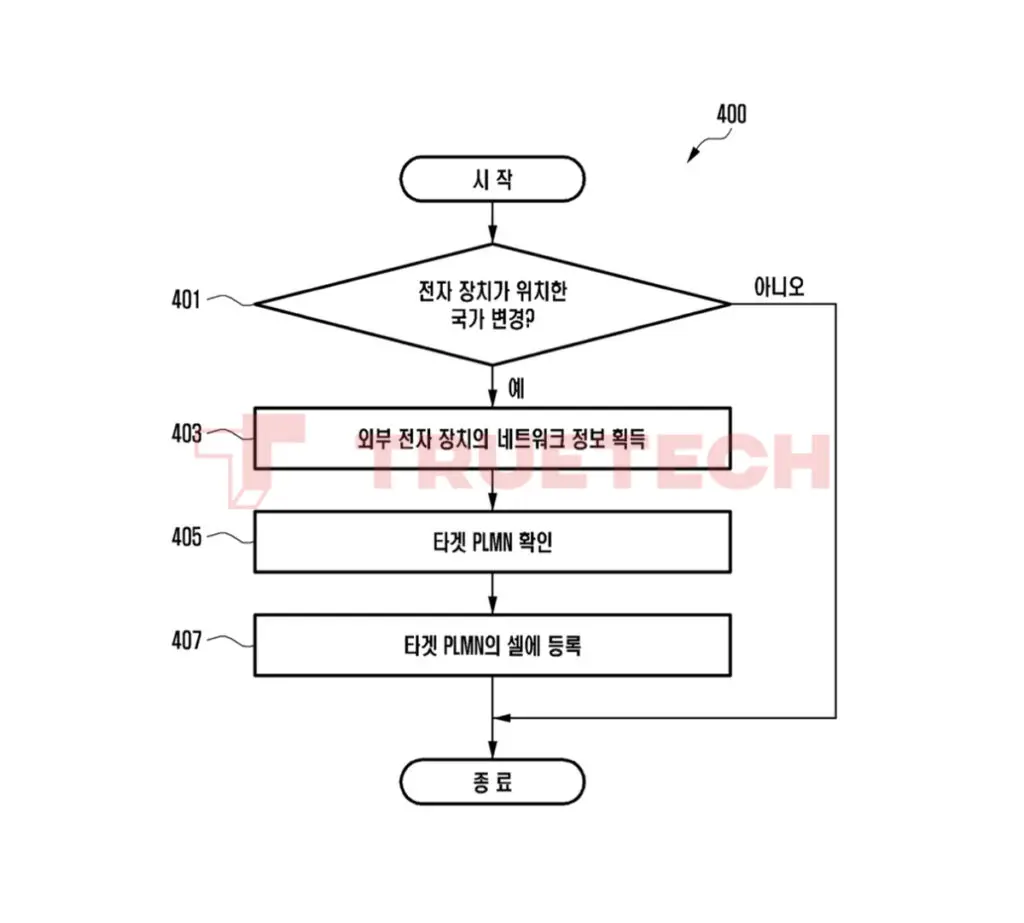
Here is an easy explanation of the diagram:
- The Galaxy S25 (or the processor connecting the patented tech) checks if you are in a new country.
- If so, it uses BLE to get network information from nearby devices.
- The phone uses information obtained to detect which PLMN to use.
- It connects to the best PLMN (cellular network).
- The process terminates when the phone is registered and connected to the new network.
In addition to that, looking back at Hwang’s internship experience description, he also referenced the “key-value storage system” being capable to handle “400+ PLMNs per device.” This perhaps refers to the memory in the patent. In our interpretation, this patented system will be able to store and handle information from over 400 PLMNs at once, making connection and reconnection faster.
While we did our best to explain the patent, its technical details, and how it would benefit you in your day to day life, there are intricacies that can only be gathered by experts after perusing the patent thoroughly. Below are the claims that the patent explores including their translations.
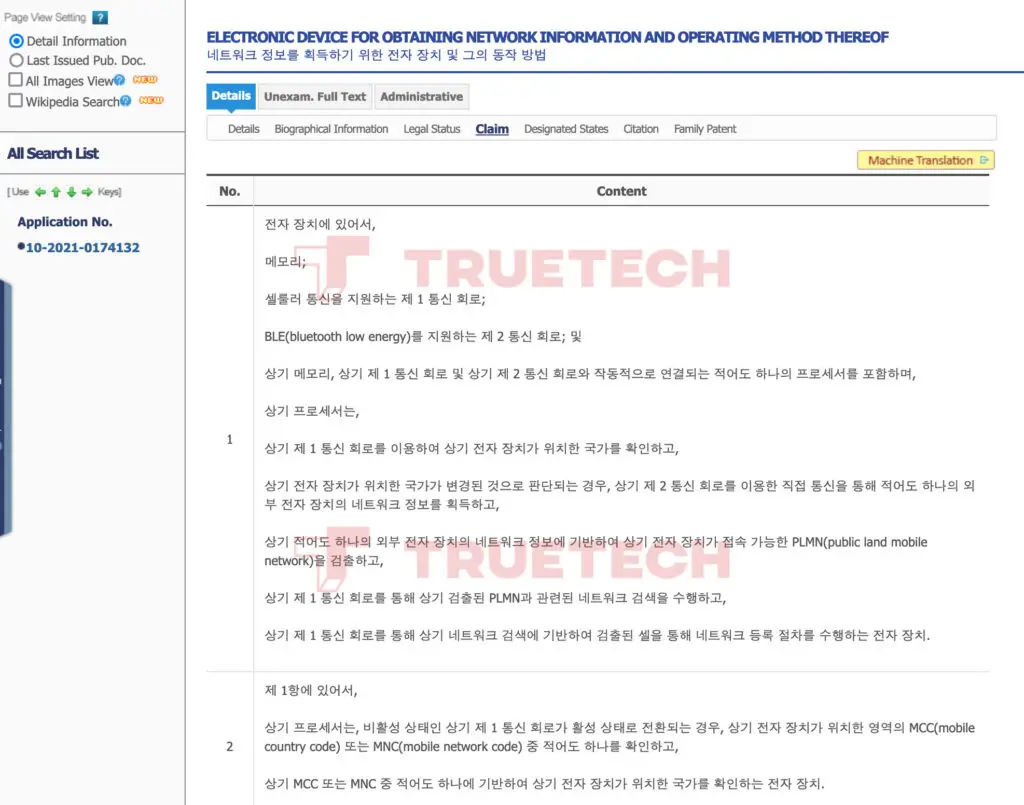
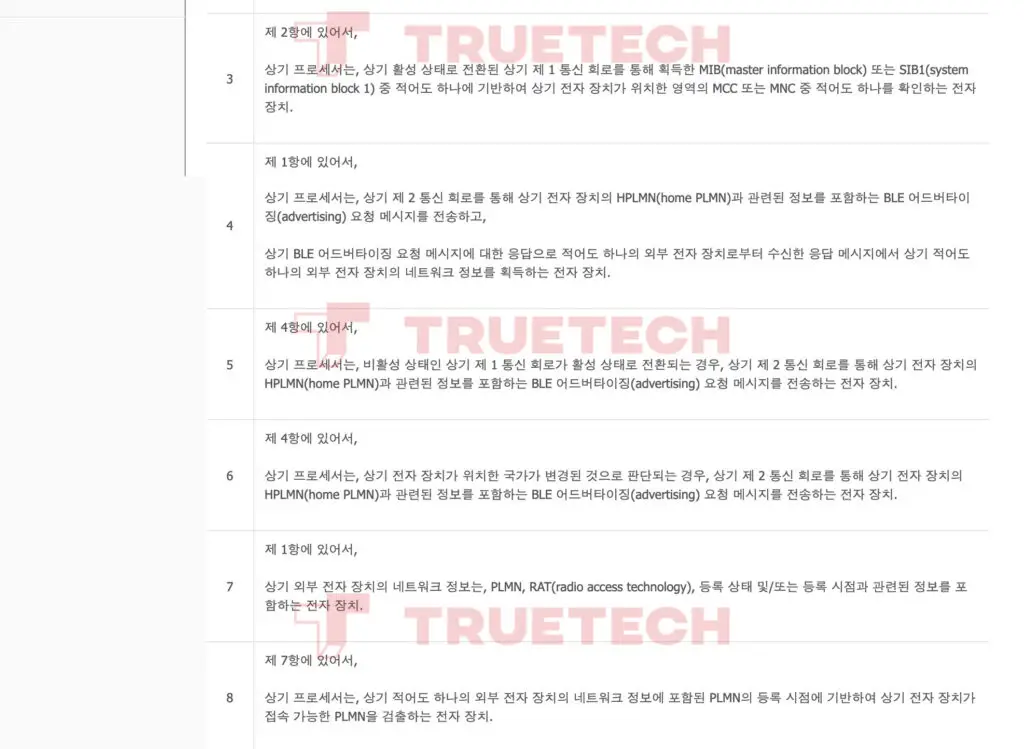
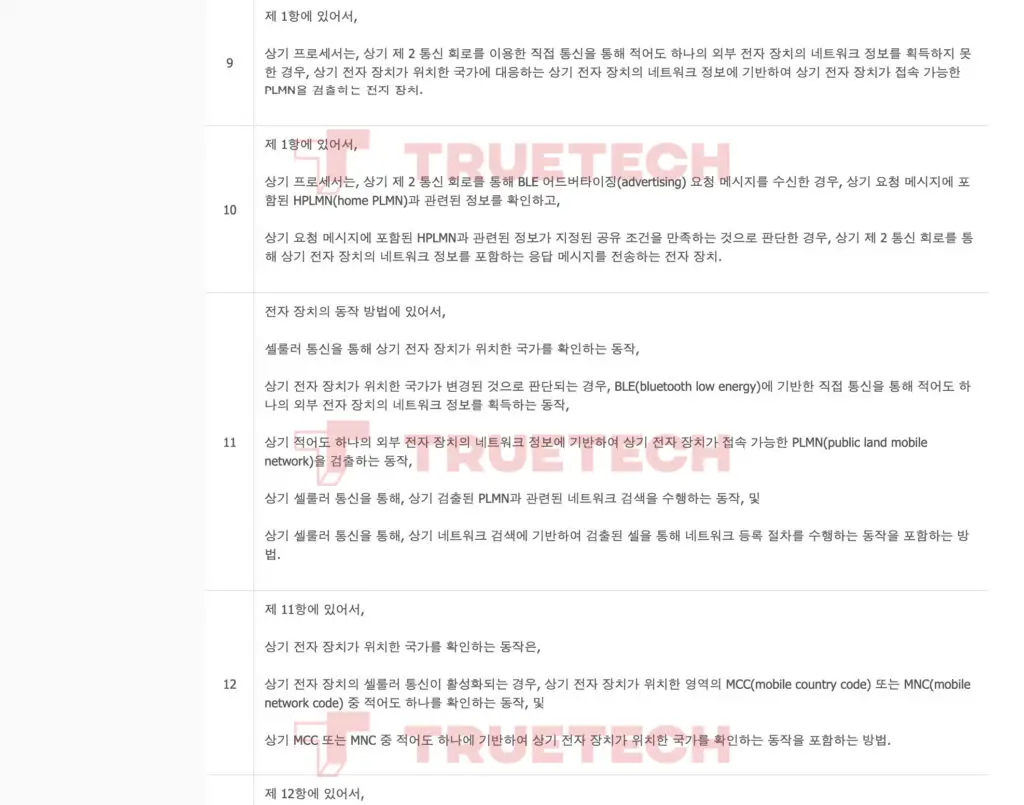
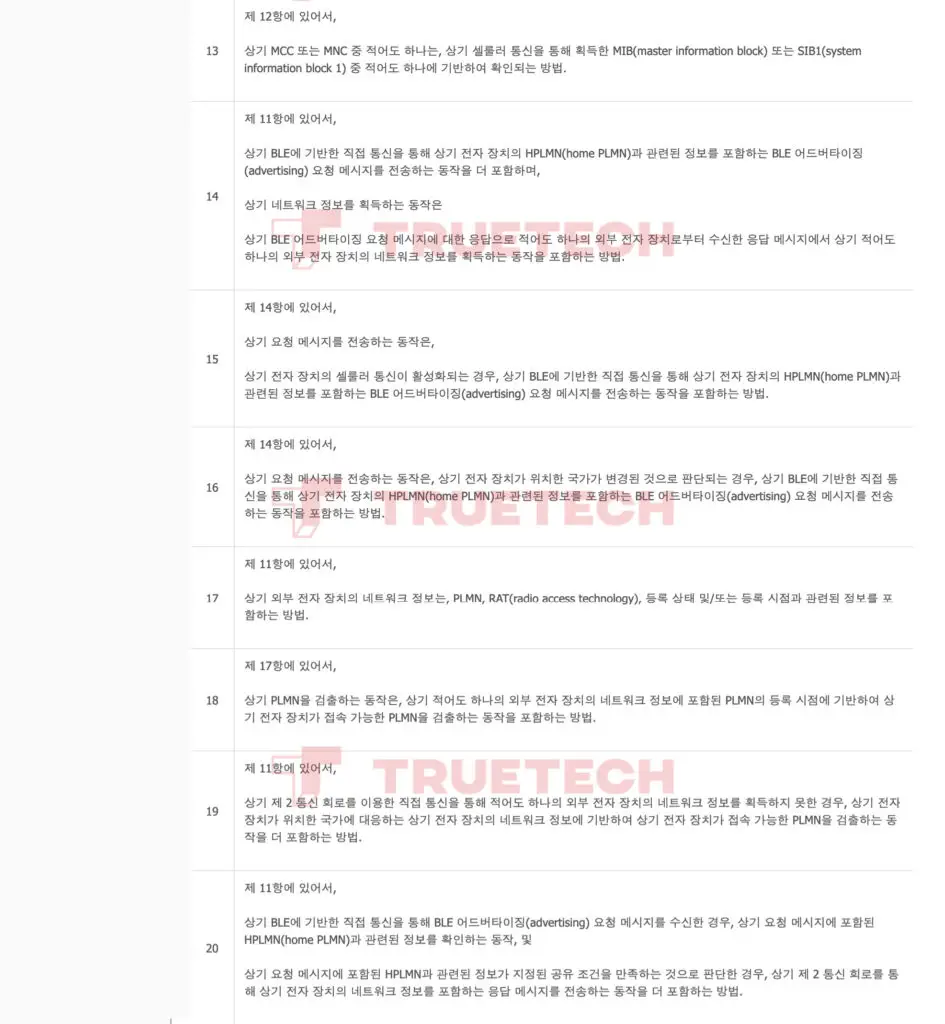
Here are the translations generated using AI and Google Translate:
| No | Claim | No | Claim |
| 1 | In electronic devices, Memory; a first communication circuit supporting cellular communication; A second communication circuit supporting BLE (bluetooth low energy); and At least one processor operatively connected to the memory, the first communication circuit, and the second communication circuit, The processor, Confirming the country in which the electronic device is located using the first communication circuit, If it is determined that the country in which the electronic device is located has changed, obtain network information of at least one external electronic device through direct communication using the second communication circuit, Detecting a public land mobile network (PLMN) accessible to the electronic device based on network information of the at least one external electronic device, Perform a network search related to the detected PLMN through the first communication circuit, An electronic device that performs a network registration procedure through a cell detected based on the network search through the first communication circuit. | 11 | 11 In a method of operating an electronic device, An operation of confirming the country in which the electronic device is located through cellular communication, When it is determined that the country in which the electronic device is located has changed, an operation of acquiring network information of at least one external electronic device through direct communication based on BLE (bluetooth low energy); An operation of detecting a public land mobile network (PLMN) accessible to the electronic device based on network information of the at least one external electronic device; An operation of performing a network search related to the detected PLMN through the cellular communication, and A method comprising performing a network registration procedure through the cellular communication and through a cell detected based on the network search. |
| 2 | According to paragraph 1, When the first communication circuit in an inactive state is switched to an active state, the processor checks at least one of a mobile country code (MCC) or a mobile network code (MNC) of the area where the electronic device is located, An electronic device that identifies the country in which the electronic device is located based on at least one of the MCC or the MNC. | 12 | According to paragraph 11, The operation of checking the country in which the electronic device is located is: When cellular communication of the electronic device is activated, checking at least one of a mobile country code (MCC) or a mobile network code (MNC) of the area where the electronic device is located, and A method comprising confirming the country in which the electronic device is located based on at least one of the MCC or the MNC. |
| 3 | In paragraph 2, The processor may select one of the MCC or MNC of the area where the electronic device is located based on at least one of a master information block (MIB) or a system information block 1 (SIB1) obtained through the first communication circuit switched to the active state. An electronic device that checks at least one thing. | 13 | In clause 12, A method in which at least one of the MCC or the MNC is confirmed based on at least one of a master information block (MIB) or a system information block 1 (SIB1) obtained through the cellular communication. |
| 4 | According to paragraph 1, The processor transmits a BLE advertising request message including information related to a home PLMN (HPLMN) of the electronic device through the second communication circuit, An electronic device that obtains network information of the at least one external electronic device from a response message received from the at least one external electronic device in response to the BLE advertising request message. | 14 | According to paragraph 11, Further comprising transmitting a BLE advertising request message containing information related to a home PLMN (HPLMN) of the electronic device through direct communication based on the BLE, The operation of obtaining the network information is A method comprising obtaining network information of the at least one external electronic device from a response message received from the at least one external electronic device in response to the BLE advertising request message. |
| 5 | In clause 4, When the first communication circuit in an inactive state is converted to an active state, the processor performs BLE advertising including information related to a home PLMN (HPLMN) of the electronic device through the second communication circuit. An electronic device that transmits request messages. | 15 | In clause 14, The operation of transmitting the request message is, When cellular communication of the electronic device is activated, transmitting a BLE advertising request message containing information related to the home PLMN (HPLMN) of the electronic device through direct communication based on the BLE. How to. |
| 6 | In clause 4, When it is determined that the country in which the electronic device is located has changed, the processor sends a BLE advertising request message including information related to the home PLMN (HPLMN) of the electronic device through the second communication circuit. An electronic device that transmits. | 16 | In clause 14, The operation of transmitting the request message includes BLE advertising that includes information related to the home PLMN (HPLMN) of the electronic device through direct communication based on the BLE when it is determined that the country in which the electronic device is located has changed. (advertising) A method that includes the action of sending a request message. |
| 7 | According to paragraph 1, The network information of the external electronic device includes information related to PLMN, radio access technology (RAT), registration status, and/or registration time. | 17 | In clause 11, The network information of the external electronic device includes information related to PLMN, radio access technology (RAT), registration status, and/or registration time. |
| 8 | In paragraph 7, The processor detects a PLMN accessible to the electronic device based on a registration time of the PLMN included in network information of the at least one external electronic device. | 18 | According to paragraph 17, The method of detecting the PLMN includes detecting a PLMN accessible to the electronic device based on a registration time of the PLMN included in network information of the at least one external electronic device. |
| 9 | According to paragraph 1, If the processor fails to obtain network information of at least one external electronic device through direct communication using the second communication circuit, the processor determines the electronic device based on the network information of the electronic device corresponding to the country in which the electronic device is located. An electronic device that detects the PLMN to which the device can connect. | 18 | According to paragraph 11, If network information of at least one external electronic device is not obtained through direct communication using the second communication circuit, the electronic device may be connected based on the network information of the electronic device corresponding to the country in which the electronic device is located. A method further comprising the operation of detecting a PLMN. |
| 10 | According to paragraph 1, When receiving a BLE advertising request message through the second communication circuit, the processor checks information related to a home PLMN (HPLMN) included in the request message, An electronic device that transmits a response message including network information of the electronic device through the second communication circuit when it is determined that the information related to the HPLMN included in the request message satisfies specified sharing conditions. | 20 | According to paragraph 11, When a BLE advertising request message is received through direct communication based on the BLE, an operation of checking information related to a home PLMN (HPLMN) included in the request message, and The method further includes transmitting a response message including network information of the electronic device through the second communication circuit when it is determined that the information related to the HPLMN included in the request message satisfies a specified sharing condition. |
Final Thoughts
The two clues clarifies on Samsung’s focus to improving overall connectivity of their devices when traveling. Should this technology be implemented on the next Galaxy device, the amount of time you have to wait for your phone to connect to a network after turning airplane mode off will reduce significantly.
The use of BLE intriguing to us. Such technology also opens gates to faster connectivity when you are in a region where traditional network search might be more difficult. Devices can inter-connect and communicate with each other to reduce the load that traditional cellular connectivity search can put on your phone’s battery.
Overall, it is interesting to see Samsung pursue a front that is less explored. A faster roaming connectivity experience could make the upcoming S25 more appealing to users who travel internationally often, while giving Samsung devices an edge when compared to iPhone’s satellite connectivity, despite the two technologies being significantly different.
